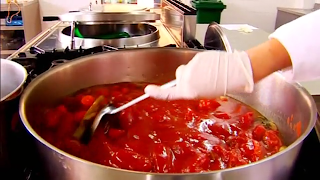Finland: The Basics
G’day mates, as my new Aussie friends have taught me :) I hope you are having a fulfilling day! I am writing from my hostel in Brussels, Belgium, an unexpected, yet pleasant, resting spot. See, I was intending to stay in Stockholm until September 26, but I accidentally booked my housing for September 16 … so, I made a spur of the moment decision and come to Brussels.
[The amazing Jubelpark]
I was not the largest fan of Brussels at first, but throughout the week, I’ve seen beautiful scenes and had great conversations to change my perception. My favorite spot is the Jubelpark, a gorgeous park that spans for kilometers. My favorite foodie spot is a patisserie that isn’t on Google Maps - but it has amazing baked goods for a steal. I got a huge croissant for a euro - that simply doesn’t happen in Brussels!
[Well, it's a piece of the amazing croissant ...]
Visiting the Finnish school lunch program may seem like a long time ago, I’ve continually been mulling over the program in my mind. However, before I talked about the program, I think it is important to contextualize the program by talking about Finland’s fast facts, as well as its educational, political, and cultural structure.
Population: the population of Finland is almost 5.5 million people. Seems small, doesn’t it? Well, it is. The population density is so low in Finland, that every citizen could own 23 square miles of the country. This is important to keep in mind because there are more American children in school than the entire population of Finland. There are 50.4 million students in American schools, in comparison to 900,000 students in Finnish schools. Population has multiple potential influences on the school lunch program: the Finnish government can afford to spend more than American government on meals … but meal costs are less expensive in America due to economies of scale. I can’t predict the power of these two phenomena (why I am an anthropology major, not a statistics major), but want to point out the large difference in population.
Political and economic system: The Finnish government is comprised of an Executive branch (a weaker president and stronger Prime Minister), Legislative branch (Parliament, I would argue the most powerful branch), and Judicial branch. The Parliament, called “Eduskunta,” typically has 8-10 parties represented. I mention this (and will make a post about this later) because the Eduskunta is currently debating rescinding several of its most progressive education and social policies - which directly impacts the school lunch program. More about this later. ;)
The Finnish economy is worthy to note, too. One word: taxes. Taxes, taxes, taxes. Take a look at the income tax rate below:
Taxable earned income (euros)
|
Basic tax amount
|
Rate within brackets
|
16,700–25,000
|
8
|
6.5%
|
25,000–40,800
|
547.50
|
17.5%
|
40,800–72,300
|
3,312.50
|
21.5%
|
72,200–
|
10,085
|
31.75%
|
Some readers are cringing, while the liberal inside of me dances for joy. The Finnish government taxes its citizens at high rates, but these funds are used for free education (K-12 and college) and other public services such as healthcare, childcare, and social net programs. The Finnish national school lunch program is a direct recipient of this tax system, allowing the government to provide every child with free meals in school.
Education in Finland
Inherent educational differences: Without throwing America under the schoolbus (haha, get it?), Finland’s education system outperforms America’s education in nearly all measures. If you have never seen Waiting for Superman, check it out - it’s a jarring documentary that compares the American and Finnish public school systems. But not only is student achievement indicative of a better school system, but Finnish teachers are treated significantly better than American teachers. While teaching is considered a “fallback” career in America (Have you ever heard the quote, “Those who can’t do, teach?” It’s awful.), a Finnish teaching candidate needs a master’s degree to even apply to teach. Furthermore, the job acceptance rate for elementary school educators is less than 10 percent in Finland.
What?
Those are similar rates to American medical and law school acceptances, to investment banking job offers … whereas in America, there are schools that do not have enough teachers on the roster. Having been in both Finnish and American schools, I can attest to a fundamentally different mindset … it’s hard to describe, but just being present in these two systems feels different. I’ll see if I can articulate this feeling in the future, and will edit this post accordingly.
In my next post, I will discuss the evaluative measures the American and Finnish programs do (or don’t) use :) Thank you all for your patience in waiting for a new post, I’ve been applying for a conference (using this research!) that has taken up a lot of my time. Hopefully I’ll get to present - I’ll let you guys know as soon as I know!
I’ll leave you guys with this picture I took of a menu from Dandoy Waffles in Brussels, Belgium. It made my day. :) I hope something makes your day, too!
Peace,
Erin




































